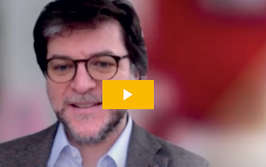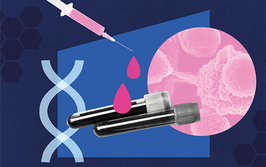From Academia to Industry
Sitting Down With… Julie Feldstein, Chief Pathologist, HistoWiz, New York, New York and Miami, Florida, USA
Michael Schubert | | 5 min read | Interview

Tell us about your background in pathology…
I knew by my fourth year of medical school that pathology – specifically hematopathology – was of strong interest to me. I was born and raised in Honolulu, Hawaii, where research opportunities were limited – so I did a Howard Hughes medical student fellowship. That’s where I found out about the National Cancer Institute (NCI) residency program, which includes a research component. I chose to do my pathology residency and hematopathology fellowship at the NCI under Elaine Jaffe. My first job was at Sloan Kettering; I spent 15 years there, then was Director of Hematopathology and the Fellowship Training Programs at Mount Sinai for six years before moving to HistoWiz.
What spurred your interest in moving from academia to industry?
I was first approached about moving from academia to industry eight years ago – and then every few years thereafter. Recently, a senior colleague advised me to seriously consider making a move and, if I didn’t do it now, I knew I never would. So, after much deliberation, I took the leap.
In academia, I felt we spent a lot of time on platforms without implementation. The unwillingness to move forward was frustrating. Moving from academia to industry was like moving from horseback travel to jet plane travel! Industry focuses on revenue, turnaround time, client satisfaction, metrics, and market analyses, with increased exposure to sales, finance, executive, and board roles. I find it all very interesting.
Have there been any unexpected differences – or similarities?
In academia, I was on the younger side; in industry, the opposite is true. My colleagues in industry tend to be young, flexible, and tech-savvy – it’s the only way to survive in such a fast-paced world. But as for the unexpected: the deep appreciation expressed by young colleagues. I’m delighted to be partially back in the lab, the administrative and regulatory layers are simpler than in academia, and working on preclinical therapeutic studies with broad outreach potential has been eye-opening and fascinating.
What do you think lies ahead for pathology?
The need for digital and computational pathology will continue among our clinical, scientific investigator, and industry colleagues. Given the ease of online access and long-distance collaboration, telepathology offers an opportunity to address the ongoing staffing shortages in our field – and the challenges of the pandemic.
There are many grassroots efforts to increase medical students’ interest in pathology, but the digital realm offers widespread outreach to colleagues who are interested in helping with those efforts. I hope that our continued progress in digital and computational pathology will make us a highly attractive discipline for future-focused students.
What advice do you have for labs struggling to go digital?
Take the leap. Face your fears, hesitations, and challenges. It’s fun and you’ll learn a lot.
Initially, browse the web, social media, news, and journals. Major pathology societies, digital pathology societies, and various clinical and scientific meetings have had discussion panels about the status quo and future of digital pathology, as well as platforms and focused sessions to share abstracts. Embedded in these conversations are explorations of computational pathology, artificial or augmented intelligence, and image analysis tools to assist pathologists with integrated reporting. Nevertheless, H&E remains the gold standard.
You have always been deeply invested in education. How does that translate to industry?
I was told by a senior colleague early on that one cannot teach and train unless one has experience. The more time you spend in a role, the more opportunities you get to educate. I am still asked to give lectures and offer opportunities for training and collaboration. These opportunities translate into education for those interested in a change, to hear about the differences, or as career options. I also have daily conversations in the lab in with young colleagues looking for insight, guidance and direction.
If you’re considering a move to industry, know that funding – and risk – may vary. There can be a lot of movement, change, acquisitions, and mergers. Expectations, pace, and demands can be high. Projects must be completed in a timely manner. Quality, integrity, communication, and being a strong team player are important. We serve our clients just as our clinical partners serve clinicians and patients. We work hard – and we play hard.
Some say that, once you leave academia, it is harder to return. Others look at it as a spectrum, from preclinical non-human to patient clinical trials. There are strong collaborations between industry and academia. Talk to colleagues in academia and industry about their experiences – at your job, at meetings, during webinars, or on social media. Pay attention to not just medical and scientific news, but also business, finance, and tech to see where investments are being made. Be open-minded, creative, and enjoy!
You’re also active on social media. What value do you see in it?
I see tremendous value in social media for support, education, and knowledge-sharing. I don’t think there are major differences between social media use in academia, industry, and clinical disciplines. I regularly encounter colleagues from all three online – and they are always actively engaged. I think social media interaction is continually getting stronger and I love the ongoing opportunity to learn from colleagues around the world and across disciplines.
I would like to express my deepest gratitude to those colleagues for their continued support – not just from my mentors, but from collaborators, trainees, patients, friends, and family along the way.

While obtaining degrees in biology from the University of Alberta and biochemistry from Penn State College of Medicine, I worked as a freelance science and medical writer. I was able to hone my skills in research, presentation and scientific writing by assembling grants and journal articles, speaking at international conferences, and consulting on topics ranging from medical education to comic book science. As much as I’ve enjoyed designing new bacteria and plausible superheroes, though, I’m more pleased than ever to be at Texere, using my writing and editing skills to create great content for a professional audience.




















